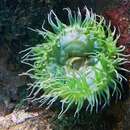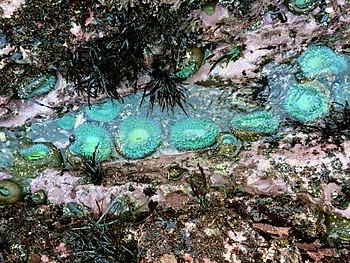en
names in breadcrumbs


Growth of individual anemones is often slow, while life spans are greatly extended. It has been found that A. xanthogrammica can live to an age of more than 80 years (Batchelder,1980; Mohler,et al.,1997).
US Federal List: no special status
CITES: no special status
This species provides no known adverse affects to humans.
Anthopleura xanthogrammica has been the source of several medical studies. Contained within its tissues, at low concentrations, is a cardiotonic agent that has been associated with favorable stimulatory effects when introduced to the vertebrate heart. Clinical studies have show that this agent is a good candidate in the treatment of a failing heart and has considerable advantages over currently used drugs. There is question as to whether harvesting naturally occuring populations of A. xanthogrammica and A. elegantissima is a feasible way to manufacture this stimulant (Batchelder,1980; Morris,et al.,1992).
The main food sources for A. xanthogrammica are mussels, sea urchins, small fish and crabs. These animals are paralyzed and captured after coming in contact with the anemones stinging tentacles. Once the prey are paralyzed, A. xanthogrammica pulls these animals into its mouth, contained in the center of its crown. When digestion is complete it excretes the waste through the same opening. The epidermis and tissues lining the gut of A. xanthogrammica contain living photosynthetic algae zoochlorellae, and the dinoflagelates zooxanthellae. These symbiotic protists can produce organic nutrients through photosynthesis that may also contribute to the nutritional needs of the anemone. It has been noted that anemones living in caves have reduced numbers of, or are completely lacking natural symbionts (Giant, 1998; Morris,et al.,1992).
Anthopleura xanthogrammica inhabits the low to mid intertidal zones of the Pacific Ocean, ranging continuously from Alaska to Point Conception. It also occurs in areas of cold upwellings possibly as south far as Panama (Smith and Potts,1987).
Biogeographic Regions: pacific ocean (Native )
Sand and rock covered shore lines are prime habitat for A. xanthogrammica. To prevent dessication due to extended periods of time with no water, these anemones will take up residence in the mid to low intertidal where they will be covered with water most of the day.
This species of anemone can grow to a column width of 17 cm and a height of 30 cm. The tentacular crown can grow to 25 cm in diameter with numerous tentacles arranged in six or more rows around the margin. The tentacles and column are green but can vary in intensity, ranging from light green in the tentacles to olive green in the column.
Stinging cells called cnidocytes are located within the tentacles. These cells help A. xanthogrammica paralyze its prey, but causes no harm to humans (Giant,1998; Morris,et al.,1992).
Other Physical Features: ectothermic ; radial symmetry
A. xanthogrammica reproduces sexually through external fertilization of sperm and eggs. Spawning generally occurs in the fall from September to November and will produce pelagic, planktotrophic larvae. These larvae float freely for a period of time until they become widely dispersed. Larvae tend to settle in established mussel beds where they will begin to develop (Smith and Potts,1987).
Parental Investment: no parental involvement


Anthopleura xanthogrammica, or the giant green anemone, is a species of intertidal sea anemone of the family Actiniidae.
Other common names for this anemone include green surf anemone, giant green sea anemone, green anemone, giant tidepool anemone, anemone, and rough anemone.[2]
The column width and height can reach a maximum of 17.5[3] and 30 cm, respectively.[4] The crown of tentacles can be as wide as 25 cm in diameter,[4] while the column, itself, tends to be widest at the base in order to offer a more stable connection to the rocks.[5]
It has a broad, flat oral disk surface[6] and no striping, banding, or other markings.[5]
If A. xanthogrammica is exposed to proper amounts of sunlight, it can appear bright green[5] when submerged under water.
When not submerged, it appears dark green or brown. This is because the anemone tends to close up and "droop" and its now exposed column is actually dark green and slightly brown, but the hidden tentacles and oral disk are bright green.[3]
The tentacles, which are short and conical,[3] are arranged in six or more rows surrounding the oral disk[4][7] and can be pointed or blunt at the tips.[5]
Generally, A. xanthogrammica is found along the low to mid intertidal zones of the Pacific Ocean, from Alaska to southern California and sometimes downwards to Panama, where cold water swells can occur.[4][5][7][8]
A. xanthogrammica prefers to inhabit sandy or rocky shorelines, where water remains for most of the day.[4] They can generally be found in tide pools up to 15 m deep.[3] Occasionally A. xanthogrammica can also be found in deep channels of more exposed rocky shores and concrete pilings in bays and harbors.[5]
Photosynthetic algae, zoochlorellae, and the dinoflagellates, zooxanthellae, live in the epidermis and tissue of the gut of A. xanthogrammica. In this symbiotic relationship, the zoochlorellae and zooxanthellae provide nutrients to the anemone via photosynthesis and contribute to the bright green color of the anemone's oral disk and tentacles.[4][7] The bright green color is also due to pigmentation.[5]
Anthopleura xanthogrammica anemones living in caves and shady zones have reduced or no natural symbionts and tend to be less colorful.[3][4][5][7]
These anemones tend to live a solitary life, but can be occasionally seen as groups with no more than 14 individuals per square meter.[4][5][7] They can move slowly using their basal disks, but usually stay sessile.[4][7] Like other anemones, A. xanthogrammica can use stinging cells located in the tentacles as protection from predators and a mechanism to capture prey.[4][7]
Anthopleura xanthogrammica reproduce sexually via external fertilization of sperm and eggs in the late fall. Newly formed pelagic, planktotrophic larvae float in the water until dispersing and settling in mussel beds.[3][4][7]
Nematocysts found in the tentacles assist A. xanthogrammica to catch and paralyze prey.[3][4][7] After feeding and digestion is complete, the anemone excretes its waste back through the mouth opening.[4][7]
Main predators of A. xanthogrammica include: the leather seastar Dermasterias imbricata,[5] the nudibranch Aeolidia papillosa and the snail Epitonium tinctum (both feed on the tentacles), and the snails Opalia chacei and Opalia funiculata and the sea spider Pycnogonum stearnsi (that feed on the column).[4][7]
The anemone feeds on sea urchins, small fish, and crabs, but detached mussels seem to be the main food source.[5][7] There are rare instances where the giant green anemone has consumed seabirds.[9] It is not known whether the birds were alive or dead when engulfed by the anemone.
Occasionally, A. xanthogrammica can be confused with large individuals of A. elegantissima or A. sola, but both of these other anemones have (usually) pink-tipped tentacles and a striped oral disk, unlike A.xanthogrammica.[5]
 Spectacular lineup of Giant Greens at Hazard Reef, Montana de Oro State Park. Channel is about a foot (30cm) wide. It drains a large tidepool which supplies abundant good food.
Spectacular lineup of Giant Greens at Hazard Reef, Montana de Oro State Park. Channel is about a foot (30cm) wide. It drains a large tidepool which supplies abundant good food.  Giant Greens at New England Aquarium
Giant Greens at New England Aquarium Anthopleura xanthogrammica, or the giant green anemone, is a species of intertidal sea anemone of the family Actiniidae.
Other common names for this anemone include green surf anemone, giant green sea anemone, green anemone, giant tidepool anemone, anemone, and rough anemone.